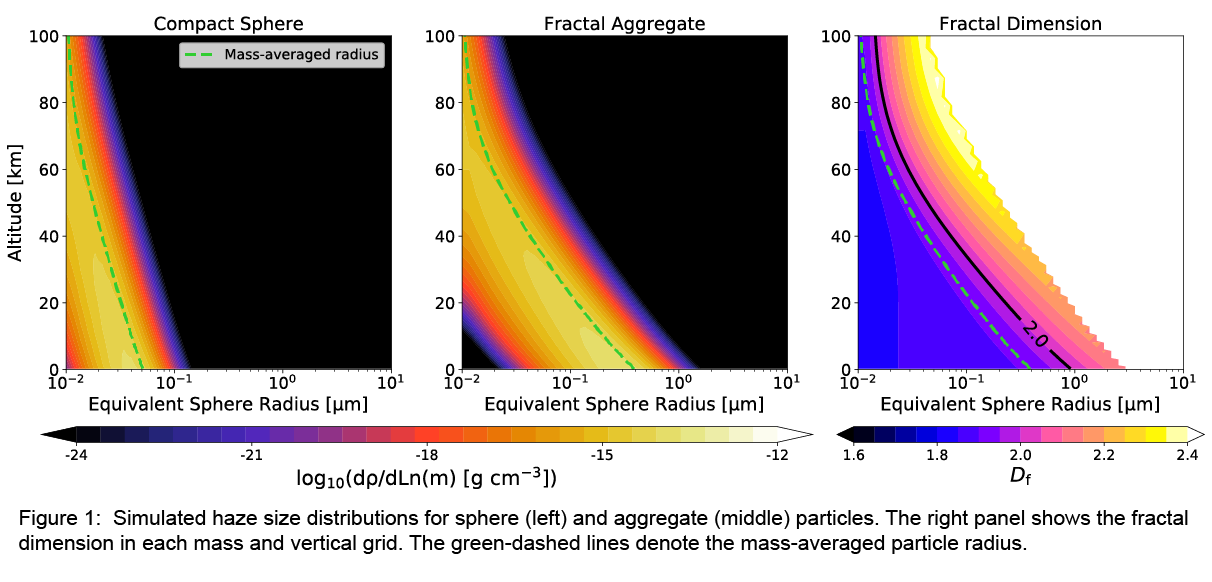Microphysics of Haze Formation on Triton
- 1Department of Astronomy and Astrophysics, University of California Santa Cruz, Santa Cruz, USA
- 2Department of Earth and Planetary Sciences, University of California Santa Cruz, Santa Cruz, USA
- 3Anton Pannekoek Institute for Astronomy, University of Amsterdam, Amsterdam, The Netherlands
- 4Department of Earth and Planetary Sciences, Tokyo Institute of Technology, Tokyo, Japan
Abstract
Aerosols are ubiquitous in planetary atmospheres in solar and extrasolar systems. Since aerosols greatly impact atmospheric thermal structures and observations, it is vital to understand how they form in a variety of environments. Here, we investigate photochemical haze formation on Triton---the largest moon of Neptune---using a detailed microphysical model. We found that simulated haze profiles without condensation of C2H4 ices hardly explain both UV and visible observations of Voyager 2 simultaneously, while icy haze models can reasonably explain the observations. Thus, condensation of hydrocarbon ice likely plays vital roles in the haze formation on Triton. Our study highlights the importance of condensation physics in haze formation, which has often been neglected in modeling studies, especially for exoplanetary hazes.
Introduction
Aerosols are universally present in atmospheres on solar system planets. Recent observations also suggest that photochemical hazes are ubiquitous even in the extrasolar planets (e.g., Sing et al. 2016, Crossfield & Kreidberg 2017). Because the hazes significantly impact on atmospheric energy balance (e.g., Zhang et al. 2017) as well as the observability of atmospheres (e.g., Lavvas & Koskinen 2017, Kawashima & Ikoma 2018, Gao & Zhang 2020, Ohno & Kawashima 2020), it is crucial to figure out how they form in a variety of environments. To this end, solar system objects provide a great opportunity to study the haze formation process thanks to abundantly available observations. Titan, Pluto, and Triton are typical solar system objects that possess hazy atmospheres. For Titan and Pluto, haze formation processes have been studied by microphysical models (e.g., Lavvas et al. 2010, 2020, Gao et al. 2017). For Triton, however, the haze formation process has not been investigated in detail since the discovery of near-surface haze layer during the Voyager 2 flyby 1989.
Methods
We have developed a new microphysical model to study the haze formation on Triton (Ohno et al. 2021). Our model simulates the evolution of both size and porosity distributions of haze particles in a self-consistent manner without assuming a specific fractal dimension (Figure 1). We compare the simulated haze profiles with those constrained by Voyager’s observations of solar occultation in UV and scattered lights in visible (Herbert & Sandel 1991, Rages & Pollack 1992). We investigate several possible nature of Triton’s haze, namely spherical and non-spherical particles with and without condensation of C2H4 ice.

Results and Discussion
Ice-free hazes, usually assumed for Titan, Pluto, and exoplanet hazes, cannot simultaneously explain both visible and UV observations of Triton’s hazes. This is because spherical hazes hardly grow into sufficiently large sizes, and aggregate hazes have low single scattering albedo with optical constants of Titan’s haze analog. We suggest that condensation of C2H4 ice onto haze particles can remedy the model-observation discrepancy by altering haze material properties, such as density and optical constants. Both ice sphere and ice aggregate models reasonably explain the existing observations of Voyager 2 (Figure 2) when the haze mass flux is comparable to the column-integrated photolysis rate of CH4. Future Triton missions with wider wavelength coverage and phase angles would be able to disentangle these two scenarios. Our results suggest the potential importance of haze-cloud interaction, which has been often neglected in modeling studies. We will also discuss the implication of haze microphysics studied here to interpret observations of exoplanetary atmospheres.
How to cite: Ohno, K., Zhang, X., Tazaki, R., and Okuzumi, S.: Microphysics of Haze Formation on Triton, European Planetary Science Congress 2021, online, 13–24 Sep 2021, EPSC2021-391, https://doi.org/10.5194/epsc2021-391, 2021.

